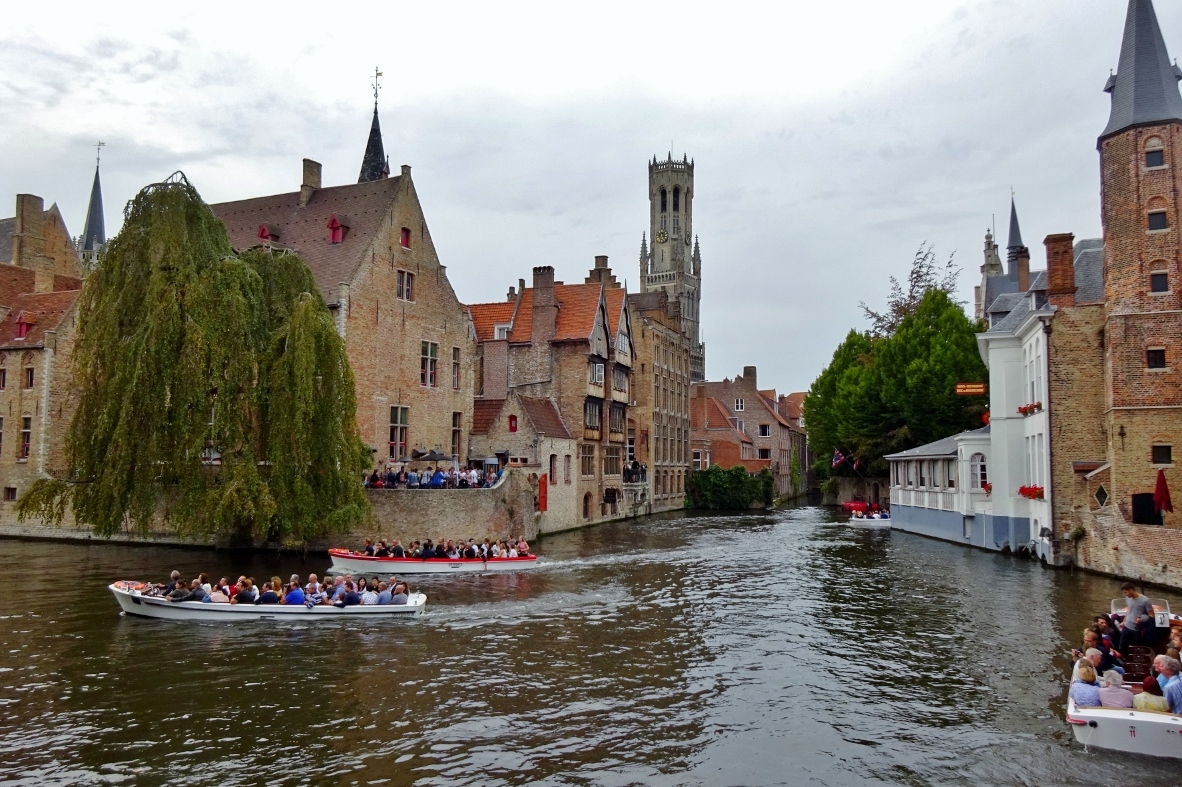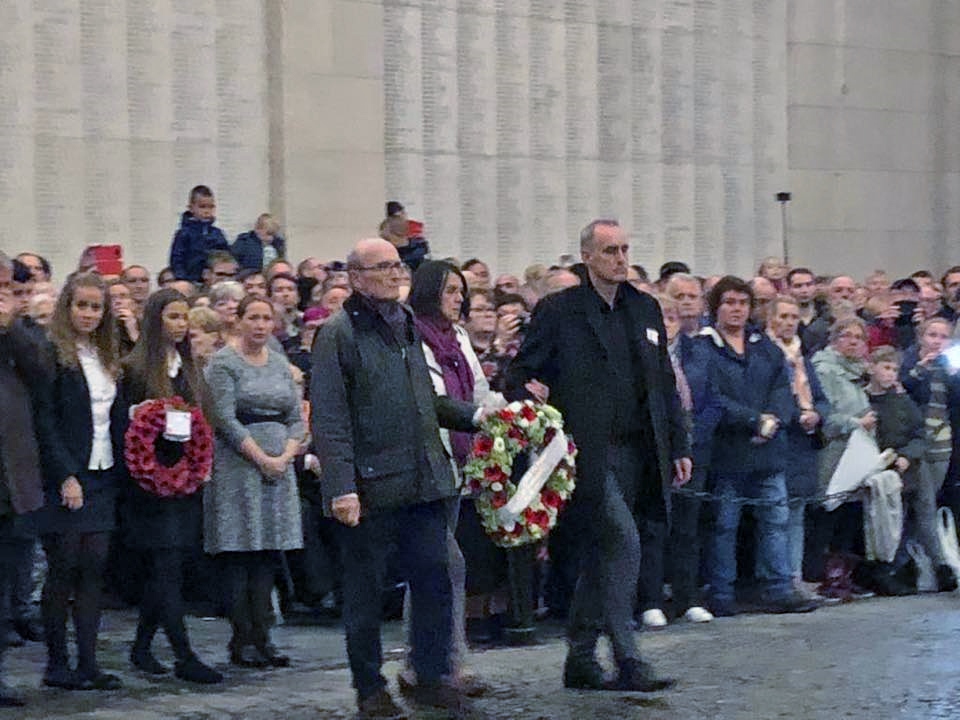2018 Link Visit to Bruges
Our annual international gathering with our Link Clubs
This year our annual Link Visit was in September to Belgium and our hosts, the Rotary Club of Brugge West, decided to arrange a special programme to commemorate the 100th anniversary of the end of the First World War. It must have been a difficult decision as our Link Visits involve the Rotary Clubs of Brugge West, Meerbusch in Germany and our Pinner club. Our hosts put together a carefully constructed programme which included visits to Langemark German cemetery, Tyne Cot Commonwealth cemetery, the Memorial Museum at Passendale and the Last Post Ceremony at Ypres. There was also a walking tour of Bruges and a visit to Saint Sebastian’s Archers Guild.
The visit started at lunchtime on Friday where we enjoyed meeting old and new friends at The Orangerie in Bruges. We were then split into groups for a walking tour of Bruges given by Brugge West members when I and some other Pinner visitors joined Filip Babylon who provided a fascinating description of the city’s history and its many ancient buildings.
That evening we visited the Town Hall where we were treated to a reception offered by City Council in the wonderfully ornate Gothic Room. Following the reception, we then went to the various homes of Brugge West members for ‘house parties’. Mike Goddard, Kate and I had a particularly enjoyable evening thanks to our generous and talented hosts, Anne and Jan Vandooren where we also met Veronique and Alain along with Bettina and Albrecht. I lost count of the numerous courses that Anne served though this may also be something to do with the amount of champagne Jan kept pouring into my glass!
Saturday was a full day spent commemorating the end of the First World War. The weather decided it would play it’s part by raining all day! First, we visited The Langemark cemetery which is the final resting place of 44,294 German soldiers. More than half of them are buried in one mass grave with their names etched on large dark plaques running alongside the site.
Our three presidents, Philip Roelens (Brugge West), Winfried Spittler (Meerbusch) and Anne Moore (Pinner) laid a wreath at Langemark. This was a ‘special’ wreath as it was made up of the remembrance flowers of each country - the forget-me-not for Germany, the daisy for Belgium and the poppy representing Commonwealth countries.
We next visited the Commonwealth cemetery at Tyne Cot. Its name is said to come from the Northumberland Fusiliers, seeing a resemblance between the many German concrete pill boxes on this site and typical Tyne side workers' cottages. It is the final resting place for 11,965 Commonwealth soldiers of which 8,369 are unnamed. It is the largest Commonwealth cemetery in the world. The concrete shelters which still stand in various parts of the cemetery were part of a fortified position of the German front line which played an important role during the Battle of Passchendaele in 1917.
Tyne Cot cemetery looks very different to Langemark with its white marble, Portland stone and red roses. It is one of over 100 Commonwealth, one German, two French and one Belgian military cemetery in the Ypres area. In his own private ceremony, Mike Goddard left a wooden cross at the grave of an unknown soldier.
After an emotional morning we then went to lunch at a nearby ‘local’ restaurant called D’Oude Timmerie in Zonnebeke where they served copious amounts of tasty beef stew, salad and fries.
Our afternoon was spent at the Memorial Museum Passchendaele which is housed in an historic château and its grounds at Zonnebeke. The museum provides an overview of the five battles of Ypres, including the Battle of Passchendaele using historical objects, authentic letters, posters and uniforms of the various armies. It also has a ‘Dugout Experience’ which shows how the British went to live underground in 1917 and a reconstruction of German and British trenches, along with their original shelters.
Next, we visited a Flanders farm which is still finding unexploded shells 100 years after the end of the war. The farmer stores them in a steel cage and when it’s full he informs the Belgium army who deal with them. He also showed us what had been a large German concrete bunker and, his pride and joy, a 100-year-old British Mark IV tank!
Finally, we went to Palingbeek park to see the 600,000 clay sculptures that were created by thousands of people across the world. Each one represents a victim of the First Word War and they have been installed in the park as this was once no-man’s-land between the two sets of armies.
Following an early dinner, we then went to Ypres town centre to see the Last Post Ceremony at the Menin Gate. This memorial is inscribed with the names of more than 54,000 Commonwealth soldiers who died and have no known grave. Each evening, crowds gather for the ceremony which starts at 8pm with buglers playing the last post, followed by a minute’s silence, then a piper playing. Next comes the wreath laying which on the evening we were there involved about 20 wreath layers including our three presidents. The ceremony ends with Reveille played by a bugle. It was a very moving ceremony.
Our evening ended in the bar back at our hotel where we enjoyed a glass or two with our Belgian and German friends discussing the day’s events (and Brexit)!
On Sunday morning we visited the Saint Sebastian’s Archers Guild in Bruges which has been in existence for more than 600 years. The members of this longbow guild are exclusively male, with two notable exceptions: Queen Mathilde of Belgium and the Queen of England. Ever since the exiled English king Charles II took up residence in Bruges in the 17th century, the city and the British Royal Family have always been closely associated. Charles founded both the British Grenadier Guards and the Life Guards Regiment here. A Union Jack flies in the grounds of the guild and each summer the Grenadier Guards band visits and marches across the lawns before playing chamber music for afternoon tea.
Our final lunch was at a Bruges restaurant called Panier d’Or. Following an excellent meal, the three presidents each gave a speech during which, Winfried announced that the 2019 Link Visit will be based in Meerbusch from the 20th to 22nd September.
Brian Glozier
Related pages...
.jpg)
2023 Link Visit to Bruges and Ghent
more Our annual meetings with our link clubs restarted after a break due to the pandemic
.jpg)
2019 Link Visit to Meerbusch and the Ruhr Valley
more Our 2019 get-together of the Rotary Clubs of Bruges West, Meerbusch and Pinner.
.jpg)
2017 Link Visit to Liverpool
more Exploring the city famous for football and the Beatles with our fellow Rotarians.
.jpg)

.jpg)
.jpg)
.jpg)
.jpg)
.jpg)
.jpg)
.jpg)
.jpg)
.jpg)
.jpg)
.jpg)
.jpg)
.jpg)
.jpg)
.jpg)
.jpg)
.jpg)
.jpg)
.jpg)
.jpg)
.jpg)
.jpg)
.jpg)
.jpg)
.jpg)
.jpg)
.jpg)
.jpg)
.jpg)
.jpg)
.jpg)
.jpg)
.jpg)
.jpg)
.jpg)
.jpg)
.jpg)
.jpg)
.jpg)
.jpg)
.jpg)
.jpg)
.jpg)
.jpg)
.jpg)
.jpg)
.jpg)
.jpg)
.jpg)
.jpg)
.jpg)
.jpg)
.jpg)
.jpg)
.jpg)
.jpg)
.jpeg)
.jpg)
.jpg)
.jpg)
.jpg)
.jpg)
.jpg)

.jpg)
.jpg)
.jpg)
.jpg)
.jpeg)
.jpg)
.jpg)
.jpg)
.jpg)
.jpg)
.jpg)
.jpg)
.jpg)
.jpg)
.jpg)
.jpg)
.jpg)
.jpg)
.jpg)
.jpg)
.jpg)
.jpg)
.jpg)
.jpg)
.jpg)
.jpg)
.jpg)
.jpg)